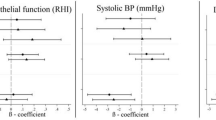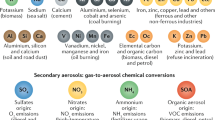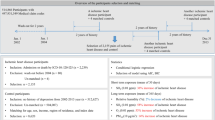Abstract
Although many studies report that exposure to air pollution harms health, few have examined associations between pollution sources and health outcomes. We hypothesized that pollution originating in different locations has different associations with heart rate variability (HRV) among 497 men from the Normative Aging Study in Boston, Massachusetts. We identified the paths that air masses traveled (‘back-trajectories’) before arriving in Boston on the days the men were examined. Next, we classified these trajectories into six clusters. We examined whether the association of measured air pollutants with HRV (standard deviation of normal-to-normal intervals, high-frequency power (HF) and low-frequency power (LF), and LF/HF ratio) differed by cluster. We also examined whether the clusters alone (not considering air pollution measurements) showed different associations with HRV. The effects of black carbon (BC) on all HRV measures were strongest on days with southwest trajectories. Subjects who were examined on days where air parcels came from west had the strongest associations with ozone. All particle pollutants (particulate matter <2.5 μm in aerodynamic diameter (PM2.5), BC, and sulfates) were associated with increased LF/HF ratio on days with relatively short trajectories, which are related to local, slow-moving air masses. We also observed significant increases in LF/HF in days where air came from the northwest and west, compared to north trajectory days. Health effects associated with exposure to air pollution can be evaluated using pollutant concentrations as well as aspects of the pollution mixture captured by identifying locations where air masses originate. Independent effects of both these indicators of pollution exposure were seen on cardiac autonomic function.
This is a preview of subscription content, access via your institution
Access options
Subscribe to this journal
Receive 6 print issues and online access
$259.00 per year
only $43.17 per issue
Buy this article
- Purchase on Springer Link
- Instant access to full article PDF
Prices may be subject to local taxes which are calculated during checkout





Similar content being viewed by others
Abbreviations
- BC:
-
black carbon
- BMI:
-
body mass index
- CI:
-
confidence interval
- ECG:
-
electrocardiogram
- HF:
-
high frequency power
- HR:
-
heart rate
- HRV:
-
heart rate variability
- IQR:
-
interquartile range
- LF:
-
low frequency power
- NOAA:
-
National Oceanic and Atmospheric Administration
- O3:
-
ozone
- PM2.5:
-
particulate matter <2.5 μm in aerodynamic diameter
- SD:
-
standard deviation
- SDNN:
-
standard deviation of NN intervals
- SO42−:
-
sulfate
References
Anthes R.A., Panofsky H.A., Cahir J.J., and Rango A. The changing weather outside the tropics. The Atmosphere, 2nd edn., Chapter 5 Charles E. Merrill Publishing Company: Columbus, Ohio, 1978, 137–170.
Bell B., Rose C., and Damon A. The Normative Aging Study: an interdisciplinary and longitudinal study of health and aging. Aging Human Dev 1972: 3: 4–17.
Brook J.R., Dann T.F., and Bonvalot Y. Observations and interpretations from the Canadian fine particle monitoring program. J Air Waste Manag Assoc 1999: 49: PM-35–PM-44.
Butler T.J., Likens G.E., Vermeylen F.M., and Stunder B.J.B. The relation between NOx emissions and precipitation NO3− in the eastern USA. Atmos Environ 2003: 37: 2093–2104.
Committee on Research Priorities for Airborne Particulate Matter, Board on Environmental Studies and Toxicology, Division on Earth and Life Studies. Synthesis of research progress on particulate matter. Research Priorities for Airborne Particulate Matter: IV. Continuing Research Progress. The National Academy Press: Washington, DC, 2004, 64–117.
Creason J., Neas L., Walsh D., Williams R., Sheldon L., Liao D., et al. Particulate matter and heart rate variability among elderly retirees: the Baltimore 1998 PM study. J Expo Anal Environ Epidemiol 2001: 11 (2): 116–122.
Draxler R.R. Trajectory optimization for balloon flight planning. Weather Forcast 1996: 11: 111–114.
Draxler R.R., and Hess G.D. An overview of the Hysplit_4 modeling system for trajectories, dispersion, and deposition. Aust Met Mag 1998: 47: 295–308.
Godleski J.J., Verrier R.L., Koutrakis P., Catalano P., Coull B., Reinisch U., et al. Mechanisms of morbidity and mortality from exposure to ambient air particles. Res Rep Health Eff Inst 2000: (91): 5–88, discussion 89–103.
Ito K., Christensen W.F., Eatough D.J., Henry R.C., Kim E., Laden F., et al. PM source apportionment and health effects: 2. An investigation of intermethod variability in associations between source-apportioned fine particle mass and daily mortality in Washington, DC. J Expo Sci Environ Epidemiol 2006: 16 (4): 300–310.
Janssen N.A., Schwartz J., Zanobetti A., and Suh H.H. Air conditioning and source-specific particles as modifiers of the effect of PM(10) on hospital admissions for heart and lung disease. Environ Health Perspect 2002: 110 (1): 43–49.
Kalkstein L.S., and Valimont K.M. An evaluation of summer discomfort in the United States using a relative climatological index. Bull Am Meteorol Soc 1986: 67: 842–848.
Laden F., Neas L.M., Dockery D.W., and Schwartz J. Association of fine particulate matter from different sources with daily mortality in six US cities. Environ Health Perspect 2000: 108 (10): 941–947.
Lanki T., de Hartog J.J., Heinrich J., Hoek G., Janssen N.A., Peters A., et al. Can we identify sources of fine particles responsible for exercise-induced ischemia on days with elevated air pollution? The ULTRA study. Environ Health Perspect 2006: 114 (5): 655–660.
Lippmann M., Hwang J.S., Maciejczyk P., and Chen L.C. PM source apportionment for short-term cardiac function changes in ApoE−/− mice. Environ Health Perspect 2005: 113 (11): 1575–1579.
Magari S.R., Schwartz J., Williams P.L., Hauser R., Smith T.J., and Christiani D.C. The association of particulate air metal concentrations with heart rate variability. Environ Health Perspect 2002: 110 (9): 875–880.
Mar T.F., Ito K., Koenig J.Q., Larson T.V., Eatough D.J., Henry R.C., et al. PM source apportionment and health effects 3. Investigation of inter-method variations in associations between estimated source contributions of PM2.5 and daily mortality in Phoenix, AZ. J Expo Sci Environ Epidemiol 2006: 16 (4): 311–320.
Mar T.F., Norris G.A., Koenig J.Q., and Larson T.V. Associations between air pollution and mortality in Phoenix, 1995–1997. Environ Health Perspect 2000: 108 (4): 347–353.
NOAA A.R.L. Gridded Meteorological Data Archives. EDAS Archive, Available at: http://www.arl.noaa.gov/ss/transport/archives.htmlAccessed August 9, 2004.
Oh J.A. Characterization and source apportionment of air pollution in Nashville, TN and Boston, MA ScD thesis, Department of Environmental Health, Harvard School of Public Health, Boston, 2000.
O'Neill M.S., Veves A., Zanobetti A., Sarnat J.A., Gold D.R., Economides P.A., et al. Diabetes enhances vulnerability to particulate air pollution-associated impairment in vascular reactivity and endothelial function. Circulation 2005: 111 (22): 2913–2920.
Park S.K., O'Neill M.S., Vokonas P.S., Sparrow D., and Schwartz J. Effects of air pollution on heart rate variability: The VA Normative Aging Study. Environ Health Perspect 2005: 113 (3): 304–309.
Pope III C.A., Burnett R.T., Thun M.J., Calle E.E., Krewski D., Ito K., et al. Lung cancer, cardiopulmonary mortality, and long-term exposure to fine particulate air pollution. JAMA 2002: 287 (9): 1132–1141.
Pope III C.A., Eatough D.J., Gold D.R., Pang Y., Nielsen K.R., Nath P., et al. Acute exposure to environmental tobacco smoke and heart rate variability. Environ Health Perspect 2001: 109 (7): 711–716.
Samet J.M., Dominici F., Curriero F.C., Coursac I., and Zeger S.L. Fine particulate air pollution and mortality in 20 US cities, 1987–1994. N Engl J Med 2000: 343 (24): 1742–1749.
Sarnat S.E., Coull B.A., Schwartz J., Gold D.R., and Suh H.H. Factors affecting the association between ambient concentrations and personal exposures to particles and gases. Environ Health Perspect 2006: 114 (5): 649–654.
SAS Institute. The SAS System for Windows, Release 8. SAS Institute Inc., Cary, NC, 2001.
Schwartz J. Air pollution and hospital admissions for heart disease in eight US counties. Epidemiology 1999: 10 (1): 17–22.
Schwartz J., Litonjua A., Suh H., Verrier M., Zanobetti A., Syring M., et al. Traffic related pollution and heart rate variability in a panel of elderly subjects. Thorax 2005: 60 (6): 455–461.
Steadman R.G. The assessment of sultriness. Part II: effects of wind, extra radiation, and barometric pressure on apparent temperature. J Appl Meteor 1979: 18: 874–885.
Stohl A. Computation, accuracy and applications of trajectories –– a review and bibliography. Atmos Environ 1998: 32 (6): 947–966.
Stull R.B. Mean boundary layer characteristics. An Introduction to Boundary Layer Meteorology. Kluwer Academic Publishers: Dordrecht, The Netherlands, Chapter 1 1988, 1–25.
Stunder B.J.B. An assessment of the quality of forecast trajectories. J Appl Meteor 1996: 35: 1319–1331.
Task Force of the European Society of Cardiology and the North American Society of Pacing and Electrophysiology. Heart rate variability: standards of measurement, physiological interpretation and clinical use. Circulation 1996: 93 (5): 1043–1065.
Utell M.J., Frampton M.W., Zareba W., Devlin R.B., and Cascio W.E. Cardiovascular effects associated with air pollution: potential mechanisms and methods of testing. Inhal Toxicol 2002: 14 (12): 1231–1247.
Wotawa G., and Kroger H. Testing the ability of trajectory statistics to reproduce emission inventories of air pollutants in cases of negligible measurement and transport errors. Atmos Environ 1999: 33: 3037–3043.
Acknowledgements
This work was supported by the National Institute of Environmental Health Sciences (NIEHS) (ES00002, PO1 ES009825) and the US Environmental Protection Agency (EPAR827353). The VA Normative Aging Study is supported by the Cooperative Studies Program/Epidemiology Research and Information Center of the US Department of Veterans Affairs and is a component of the Massachusetts Veterans Epidemiology Research and Information Center, Boston. S.K.P. and M.S.O. were supported by training grant T32 ES07069 from the NIEHS, National Institutes of Health. Its contents are solely the responsibility of the authors and do not necessarily represent the official views of the NIEHS. M.S.O. was supported by the Robert Wood Johnson Foundation Health & Society Scholars program.
We thank E.R. Dibbs and J.D. Awerbach for their invaluable assistance in conducting the heart rate variability measurements and other contributions to the VA Normative Aging Study.
Author information
Authors and Affiliations
Corresponding author
Rights and permissions
About this article
Cite this article
Park, S., O'Neill, M., Stunder, B. et al. Source location of air pollution and cardiac autonomic function: Trajectory cluster analysis for exposure assessment. J Expo Sci Environ Epidemiol 17, 488–497 (2007). https://doi.org/10.1038/sj.jes.7500552
Received:
Accepted:
Published:
Issue Date:
DOI: https://doi.org/10.1038/sj.jes.7500552
Keywords
This article is cited by
-
Development of a modeling approach to estimate indoor-to-outdoor sulfur ratios and predict indoor PM2.5 and black carbon concentrations for Eastern Massachusetts households
Journal of Exposure Science & Environmental Epidemiology (2018)
-
Modeling indoor particulate exposures in inner-city school classrooms
Journal of Exposure Science & Environmental Epidemiology (2017)
-
Boundaries of air mass trajectory clustering: key points and applications
International Journal of Environmental Science and Technology (2017)
-
Haze observations by simultaneous lidar and WPS in Beijing before and during APEC, 2014
Science China Chemistry (2015)
-
Asthma exacerbation is associated with particulate matter source factors in children in New York City
Air Quality, Atmosphere & Health (2014)



